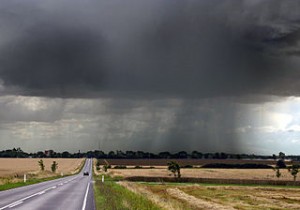How Far Will an Electric Car Go On A Charge?
This is not an easy question to answer as there are a lot of factors that affect range.
A typical family-sized electric car as of writing (2014) will have a usable range under normal conditions of about 100 miles but this varies considerably. It could be as low as 40 miles or less or as high as 130 miles depending on the factors below but as a general guide 100 miles is a good starting point.
Some cars are considerable less with the Renault Twizy for example clocking in at about 50 miles but the Twizy is really only designed for urban use.
Some cars are considerable more with the Tesla Model S P85+ 85kWh[2] coming in at about 265 miles EPA.
Main Issues Affecting Range
The following are the main factors that affect range:
Battery Capacity

By far the biggest factor is the capacity, or size, of the battery. An electric vehicle is fitted with a battery which holds a certain about of charge, usually quoted in kiloWatt hours (kWh). Typically, as a rough guide, electric cars get about 3-4 miles/kWh of range under normal conditions although this can vary hugely depending on the car, model, temperature, terrain, speed, load etc (see below) but it is a pretty good starting point.
So, with this as a starting point you can estimate a car’s range in miles as approximately 3-4 times its battery capacity in kWhs. e.g. A Nissan Leaf has a usable battery capacity of 22kWh and so has an approximate range of about 72-96 miles.
Speed
![© Moros [GFDL or CC-BY-3.0]](https://electricbluetesla.org/wp-content/uploads/320px-Verkehr_1735-300x188.jpg)
The biggest variable that can be controlled by the driver to affect range is speed. Put simply, the faster you go the less range you will get. This is true of all cars and not just EVs.
The important thing to remember is that the affect speed has on range is not linear. In other words, go twice the speed and it will not half the range. Increasing speed has an increasing affect on range. Typical speeds of about 50-60mph will give you sensible range but to get more range you can drive more slowly where it is safe to do so. The best range is often achieved at about 20-25mph but driving at that speed, except in town, is not practical. Driving faster than 60mph will reduce range significantly.
Acceleration
![© Oleh Kernytskyi [CC-BY-SA-3.0],](https://electricbluetesla.org/wp-content/uploads/Colt02-2.jpg)
Hard acceleration will reduce range. To get best range accelerate smoothly and as gently as safety and traffic conditions allow. Always drive with consideration of other traffic.
Some cars have an “ECO” mode that changes the response of the throttle pedal making it less sensitive. This helps to prevent you applying more throttle than you need to move at any particular speed and so extends range.
Use “ECO” mode if you have it to help prevent you using more throttle than necessary.
Braking
![© Tharish [CC-BY-SA-3.0],](https://electricbluetesla.org/wp-content/uploads/320px-Brake_caliper_honda_jazz-300x168.jpg)
One of the biggest factors in achieving good range is how much and how hard you use the brake. Each time you use the brake pedal you waste energy and are reducing your range. Brakes slow a car down by the friction between the brake pads and discs (rotors). That friction slows the car down converting the energy of movement (kinetic energy) into heat. The more you use the brakes the more energy you waste as heat and the less your range.
Most, if not, all electric cars today have a system to help reduce the need to use the mechanical brakes when slowing down. It is Regenerative Braking. Regen braking uses the electric motor to slow the car rather than the mechanical brake pads. The motor then uses the energy of movement to generates electricity and that charges the battery thereby recovering (or regenerating) some of the energy that would have been lost to heat with normal brakes.
Regen braking systems are seamless and do not require any special controls but the motor can only slow a car by so much and so if you are heavy on the brakes the car will need to use the mechanical brakes in addition to the motor to slow you down quickly.
Many EVs have special modes (“ECO” or “B”) that increase the amount of regenerative braking that is available just by lifting the throttle pedal. With careful driving this can reduce, or significantly reduce, the amount you need to use the brake pedal and so reduce the chance of inadvertently applying the mechanical brakes.
Use “ECO” or “B” mode to increase the effectiveness of regen braking when lifting the throttle pedal when you can.
Temperature
![Thermometer© By Walta (Own work) [CC-BY-SA-3.0], via Wikimedia Commons](https://electricbluetesla.org/wp-content/uploads/Thermometer_R.jpg)
© By Walta (Own work) [CC-BY-SA-3.0], via Wikimedia Commons
Although temperature does affect ICE cars to some extent it has a significant effect on EVs. This is because the capacity of the battery is reduced as the temperature lowers.
Every EV is affected by temperature differently but as a rough guide based on the Nissan Leaf Mk1, at 22degsC average range is about 76 miles and at 0degC that reduces to about 65 miles.
Some EVs have systems on the car that warms the battery pack to the optimum temperature to allow for maximum range. This so called “pre-warming” has varying degrees of success and is only really of benefit if the car is plugged in allowing the pre-heating power to come from the grid instead of the batteries
Headwind or Tailwind
This can have a surprising affect of the range of an EV and a strong headwind can knock several miles off the range.
One way to help reduce the effects of wind and air resistance in general is to drive behind a large truck or coach although care must be taken to drive safely and to drive with a safe stopping distance to the vehicle ahead allowing for conditions. It is tempting to get closer to the vehicle ahead to “slipstream” and this will reduce wind resistance and increase range but the extra range gained is not worth driving unsafely or risk of getting a ticket!
Drive safely at all times.
Rain

The effect of rain on range is difficult to determine but it is bound to have some effect due to extra rolling resistance of the tyres on the road. In addition, you will have additional ancilliary equipment on (wipers, lights, heater etc) and this will all affect range.
When driving an EV in rain be aware that you may not get the range you would normally expect in dry conditions.
Terrain and Hills

It is not uncommon for the new EV owner to ignore the effect of hill on range. They effect the range and mpg on all cars, including petrol/diesel too, but people seldom notice. In an EV it can be critical as hills affect range considerably. Again, the degree to which range is reduced is difficult to quantify but it could be by as much as 25% or more.
There is a strange effect though when climbing hills in an EV which is worth noting. As an EV climbs a hill it will use extra energy to raise the altitude of the car. This is storing up energy (potential energy). At the top it has less battery power remaining but some of that power was converted into potential energy as it climbed. Now, coming down, it loses that potential energy and some of it increases the speed of the car. this is why things accelerate when descending hills. So, because this potential energy is driving the car less energy is needed from the battery.
This is all very technical but it can have a massive effect on the range of an EV because in all of this much energy is lost and so range is reduced.
Always check the terrain on your route and if it is hilly make an allowance for reduced range. There are web sites that can help you determine the hills on a route.
Heating and Air Conditioning
![© Jacklee [CC-BY-SA-3.0],](https://electricbluetesla.org/wp-content/uploads/Air_conditioning_units_Richmond_Hall_Menil_Collection_Houston_Texas_-_20130915-300x200.jpg)
With a petrol/diesel car it is normally heated by the heat generated by the engine but as there is no engine in an EV so the heat must be generated some other way. In many cars this is simply a resistive electric heater, similar to an electric fire in the home. Imagine a 3kW electric fire on all the time and you will see the amount it will reduce range. In fact, if on at full power for one hour, using our guidelines above, it would reduce range by about 9-12 miles. This is typical of cars that use this kind of heating.
Many newer models now have a heat pump which creates the necessary heat to heat the cabin but with a reduced load on the battery there by reducing the reduction in range. A typical reduction in range of a car with a heat pump is 3-4 miles if on all the time.
Loading and Number of Passengers
![© Keith Kristoffer [CC-BY-2.0],](https://electricbluetesla.org/wp-content/uploads/Jeepney_overloaded-300x197.jpg)
The heavier the car the less the range. You will get less range with a full car than with you on your own and this may be significant.
There are a number of other issues surrounding and associated with range:
Estimated Range
The vehicle’s electronics can only ever estimate how far the vehicle will go given the current state of charge and using assumptions for everything else and it then calculates the estimated range by looking at the history of journeys in the recent past. This estimate is sometimes quite inaccurate as those assumptions are often wrong and that is why EV drivers tend to call the estimated range display the “guess-o-meter”.
Manufacturer’s Range Claims
The manufacturer of the vehicle will quote in their specification a figure for the car’s range that is derived from an approved test[5]. The test is actually entirely unrepresentative of anything a normal driver might do in the real world and is also over a very short distance and so not using much of the battery power. The only time a car might reach the quoted range is on an entirely flat smooth road, at the most expedient temperature for the car, at the most efficient speed with no braking or unnecessary acceleration, with no use of vehicle heating.
In the real world, drivers get to know their car, and find out how to drive most efficiently, and derive workable numbers for miles per kWh that take into account the variables above.
Using an EV for Long Trips
Many EVs have rapid charging systems that allow the car to be charged in minutes rather than hours and so electric vehicles are no longer confined to local trips only.
Cars such as the Nissan Leaf, Mitsubishi i-Miev, Peugeot Ion, Renault Zoe ZE and BMW i3 all have options for rapid charging. With rapid charging on board these cars can now be driven similar distances in a single day to a petrol/diesel car with stops of 30-45 mins to charge up. Rapid charging is being installed at most of the motorway service areas and over the coming year there will be a huge increase in rapid chargers being installed by county and city councils making it even easier to use EVs for long trips.
At the moment it is true that it is not possible to drive an EV anywhere in the UK without planning your route to include stops for charging but as battery technology improves (hence car range improves) and as the number of rapid chargers increase so it will eventually get to the stage where stopping to charge becomes just something we do just like stopping to fill with petrol or stopping for lunch.
